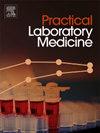Integrative analysis of exosomal ncRNAs and their regulatory networks in liver cancer progression
IF 1.7
Q3 MEDICAL LABORATORY TECHNOLOGY
引用次数: 0
Abstract
Background
Hepatocellular carcinoma (HCC) is a significant global health challenge with complex molecular underpinnings. Recent advancements in understanding the role of non-coding RNAs (ncRNAs) and exosomes in cancer biology have opened new avenues for research into potential diagnostic and therapeutic strategies.
Methods
This study utilized a comprehensive approach to analyze gene expression patterns and regulatory networks in HCC. We integrated RNA sequencing data gathered from both tissue samples and exosomes. The WGCNA and limma R packages were employed to construct co-expression networks and identify differentially expressed ncRNAs, including long non-coding RNAs (lncRNAs) and circular RNAs (circRNAs).
Results
Our analysis demonstrated distinct expression profiles of various ncRNAs in HCC, revealing their intricate interactions with cancer-related genes. Key findings include the identification of a network of microRNAs that interact with selected lncRNAs and their potential roles as biomarkers. Moreover, exosomal RNA was shown to effectively reflect tissue-specific gene expression changes.
Conclusions
The results of this study highlight the significance of exosomal ncRNAs in the progression of liver cancer, suggesting their potential as both diagnostic biomarkers and therapeutic targets. Future research should focus on the functional implications of these ncRNAs to further elucidate their roles in HCC and explore their applications in clinical settings.
肝癌进展中外泌体ncrna及其调控网络的综合分析
肝细胞癌(HCC)是一个具有复杂分子基础的重大全球健康挑战。近年来,对非编码rna (ncRNAs)和外泌体在癌症生物学中的作用的理解取得了新的进展,为研究潜在的诊断和治疗策略开辟了新的途径。方法采用综合方法分析HCC的基因表达模式和调控网络。我们整合了从组织样本和外泌体收集的RNA测序数据。使用WGCNA和limma R包构建共表达网络并识别差异表达的ncRNAs,包括长链非编码rna (lncRNAs)和环状rna (circRNAs)。结果我们的分析显示了不同的ncrna在HCC中的不同表达谱,揭示了它们与癌症相关基因的复杂相互作用。主要发现包括鉴定与选定的lncrna相互作用的microrna网络及其作为生物标志物的潜在作用。此外,外泌体RNA被证明可以有效地反映组织特异性基因表达的变化。结论本研究结果强调了外泌体ncRNAs在肝癌进展中的重要意义,表明它们具有作为诊断生物标志物和治疗靶点的潜力。未来的研究应关注这些ncrna的功能意义,以进一步阐明它们在HCC中的作用,并探索它们在临床中的应用。
本文章由计算机程序翻译,如有差异,请以英文原文为准。
求助全文
约1分钟内获得全文
求助全文
来源期刊

Practical Laboratory Medicine
Health Professions-Radiological and Ultrasound Technology
CiteScore
3.50
自引率
0.00%
发文量
40
审稿时长
7 weeks
期刊介绍:
Practical Laboratory Medicine is a high-quality, peer-reviewed, international open-access journal publishing original research, new methods and critical evaluations, case reports and short papers in the fields of clinical chemistry and laboratory medicine. The objective of the journal is to provide practical information of immediate relevance to workers in clinical laboratories. The primary scope of the journal covers clinical chemistry, hematology, molecular biology and genetics relevant to laboratory medicine, microbiology, immunology, therapeutic drug monitoring and toxicology, laboratory management and informatics. We welcome papers which describe critical evaluations of biomarkers and their role in the diagnosis and treatment of clinically significant disease, validation of commercial and in-house IVD methods, method comparisons, interference reports, the development of new reagents and reference materials, reference range studies and regulatory compliance reports. Manuscripts describing the development of new methods applicable to laboratory medicine (including point-of-care testing) are particularly encouraged, even if preliminary or small scale.
 求助内容:
求助内容: 应助结果提醒方式:
应助结果提醒方式:


